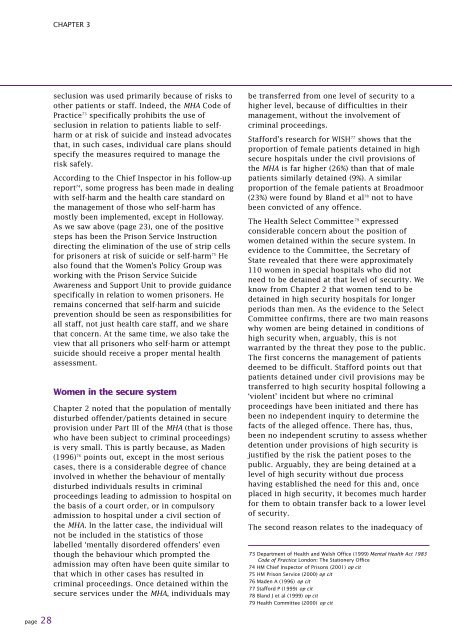Women who challenge - Nacro
Women who challenge - Nacro
Women who challenge - Nacro
- No tags were found...
You also want an ePaper? Increase the reach of your titles
YUMPU automatically turns print PDFs into web optimized ePapers that Google loves.
CHAPTER 3seclusion was used primarily because of risks toother patients or staff. Indeed, the MHA Code ofPractice 73 specifically prohibits the use ofseclusion in relation to patients liable to selfharmor at risk of suicide and instead advocatesthat, in such cases, individual care plans shouldspecify the measures required to manage therisk safely.A c c o rding to the Chief Inspector in his follow-upre p o rt 7 4 , some pro g ress has been made in dealingwith self-harm and the health care standard onthe management of those <strong>who</strong> self-harm hasmostly been implemented, except in Holloway.As we saw above (page 23), one of the positivesteps has been the Prison Service Instru c t i o nd i recting the elimination of the use of strip cellsfor prisoners at risk of suicide or self-harm 7 5 H ealso found that the Wo m e n ’s Policy Group wasworking with the Prison Service SuicideAw a reness and Support Unit to provide guidancespecifically in relation to women prisoners. Heremains concerned that self-harm and suicidep revention should be seen as responsibilities forall staff, not just health care staff, and we sharethat concern. At the same time, we also take theview that all prisoners <strong>who</strong> self-harm or attemptsuicide should receive a proper mental healtha s s e s s m e n t .<strong>Women</strong> in the secure systemChapter 2 noted that the population of mentallydisturbed offender/patients detained in secureprovision under Part III of the MHA (that is those<strong>who</strong> have been subject to criminal proceedings)is very small. This is partly because, as Maden(1996) 76 points out, except in the most seriouscases, there is a considerable degree of chanceinvolved in whether the behaviour of mentallydisturbed individuals results in criminalproceedings leading to admission to hospital onthe basis of a court order, or in compulsoryadmission to hospital under a civil section ofthe MHA. In the latter case, the individual willnot be included in the statistics of thoselabelled ‘mentally disordered offenders’ eventhough the behaviour which prompted theadmission may often have been quite similar tothat which in other cases has resulted incriminal proceedings. Once detained within thesecure services under the MHA, individuals maybe transferred from one level of security to ahigher level, because of difficulties in theirmanagement, without the involvement ofcriminal proceedings.Stafford’s research for WISH 77 shows that theproportion of female patients detained in highsecure hospitals under the civil provisions ofthe MHA is far higher (26%) than that of malepatients similarly detained (9%). A similarproportion of the female patients at Broadmoor(23%) were found by Bland et al 78 not to havebeen convicted of any offence.The Health Select Committee 79 expressedconsiderable concern about the position ofwomen detained within the secure system. Inevidence to the Committee, the Secretary ofState revealed that there were approximately110 women in special hospitals <strong>who</strong> did notneed to be detained at that level of security. Weknow from Chapter 2 that women tend to bedetained in high security hospitals for longerperiods than men. As the evidence to the SelectCommittee confirms, there are two main reasonswhy women are being detained in conditions ofhigh security when, arguably, this is notwarranted by the threat they pose to the public.The first concerns the management of patientsdeemed to be difficult. Stafford points out thatpatients detained under civil provisions may betransferred to high security hospital following a‘violent’ incident but where no criminalproceedings have been initiated and there hasbeen no independent inquiry to determine thefacts of the alleged offence. There has, thus,been no independent scrutiny to assess whetherdetention under provisions of high security isjustified by the risk the patient poses to thepublic. Arguably, they are being detained at alevel of high security without due processhaving established the need for this and, onceplaced in high security, it becomes much harderfor them to obtain transfer back to a lower levelof security.The second reason relates to the inadequacy of73 Department of Health and Welsh Office (1999) Mental Health Act 1983Code of Practice London: The Stationery Office74 HM Chief Inspector of Prisons (2001) op cit75 HM Prison Service (2000) op cit76 Maden A (1996) op cit77 Stafford P (1999) op cit78 Bland J et al (1999) op cit79 Health Committee (2000) op citpage 28
















